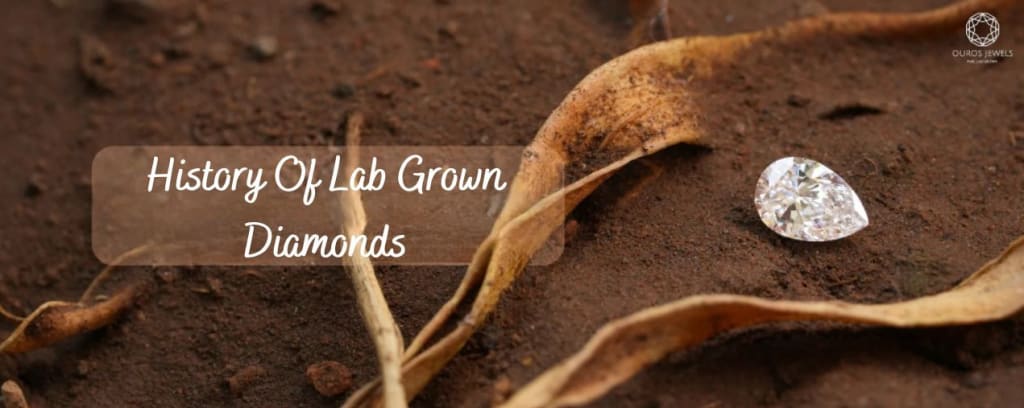History Of Lab Grown Diamonds
What Is Lab Grown Diamonds

Lab Grown Diamonds have always been in trend. Because it carries the same optical, physical, and chemical properties as Natural Diamonds. And also with higher affordability and known sourcing.
But the laboratory-produced stones that are currently available in the market are the outcome of decades of study by researchers throughout the world.
Lab-grown diamonds have a number of advantages over natural diamonds. First, they are much more environmentally friendly, as they do not require mining, which can be environmentally damaging. Second, they are more affordable than natural diamonds, as they are not subject to the same market forces. And third, they offer greater flexibility in terms of size, shape, and color, as they can be created to meet specific specifications.
What Is Lab Made Diamonds?
In a completely monitored, secure setting, a lab-grown diamond is formed in a laboratory. A sibling of a natural diamond is a lab-created diamond. These diamonds are created with the application of carbon and gases in controlled chambers during procedures like HPHT (High Pressure and High Temperature) and CVD (Chemical Vapor Deposition).
The diamond seed (crystal) is positioned in the chamber at a pressure of around 800-2500°C. Diamond seeds developed and gained form after enduring this high temperature. The carbon is coated with a diamond seed as it grows. Unnecessary carbon is taken away from the seed using a laser. After that, the diamond is completely ready for cutting and polishing.
World’s First Lab-Grown Diamond
In 1797, researchers discovered that diamonds are made entirely of carbon. The competition to produce the first synthetic diamond was sparked as a result. Many scientists throughout the 19th century tried to mimic the circumstances required for diamond creation in a lab environment. Despite several claims of success, scientists were unable to repeat these tests.
In 1954, GE produced the first synthetic diamonds that were scientifically verified to be man-made as part of a project known as "Project Super pressure." World War II delayed the development of this project, which started in the 1940s. To create diamonds from carbon, scientists have been experimenting with different processes, and temperatures, for years.
They exposed tiny seed crystals under pressures of 100,000 atm and temperatures of 1,600 degrees using a high-pressure belt press. In order to speed up the conversion of graphite to diamond, they dissolved graphite, a different mineral consisting of pure carbon, in metals such as iron, nickel, and cobalt.
They later acknowledged that they had created diamonds, and received favorable responses for that.
Special Note
There are more facts and information accessible on lab created diamonds. I've told you all, about the world's first lab-produced diamond in this post. However, click on the link if you're interested in learning more about how India began to make lab grown diamonds.
What Are VVS Diamonds?
VVS diamonds are gemologically defined as very very slightly included/inclusions. When you see the diamond clarity VVS1 or VVS2 on a diamond grading/certification report, you know those diamonds are ready to buy. VVS clarity diamonds do not have inclusions on the table or crown surface, allowing reflection lights to exit with greater power through the table.
After flawless or internally flawless diamonds, VVS diamonds are the most popular clarity grade. VVS diamonds cost 30-40% less than flawless diamonds and internally flawless diamonds.
VVS1 V/s VVS2
A VVS1 diamond is free of visible flaws such as cracks, chips, natural fractures, and so on. It has no major flaws in terms of aesthetics. It has a high level of brilliance and looks stunning.
VVS2 contains only a few minor inclusions. VVS2 diamonds have minor flaws. It doesn't look too bad; it has a few minor flaws, such as a scratch or a chip. This type of flaw has little impact on the diamond's value because most people won't notice it unless they look closely.
Special Note
Here, you have understood the basics of VVS diamonds, but there is much more to know if you want to make a purchase. If you are interested in reading and understanding more about them, then visit VVS diamond detailed guide.
About the Creator
Ouros Jewels
We deal in pure and certified lab grown diamonds and jewelry at Ouros Jewels. Founded by Vijay Sarkheliya in 2018, since then we are selling eco-friendly diamonds.
Our Social Media Handles:-
1. Linkedin
2. Instagram
3. Twitter
4. Facebook






Comments (1)
great Store about Lab Grown Diamonds